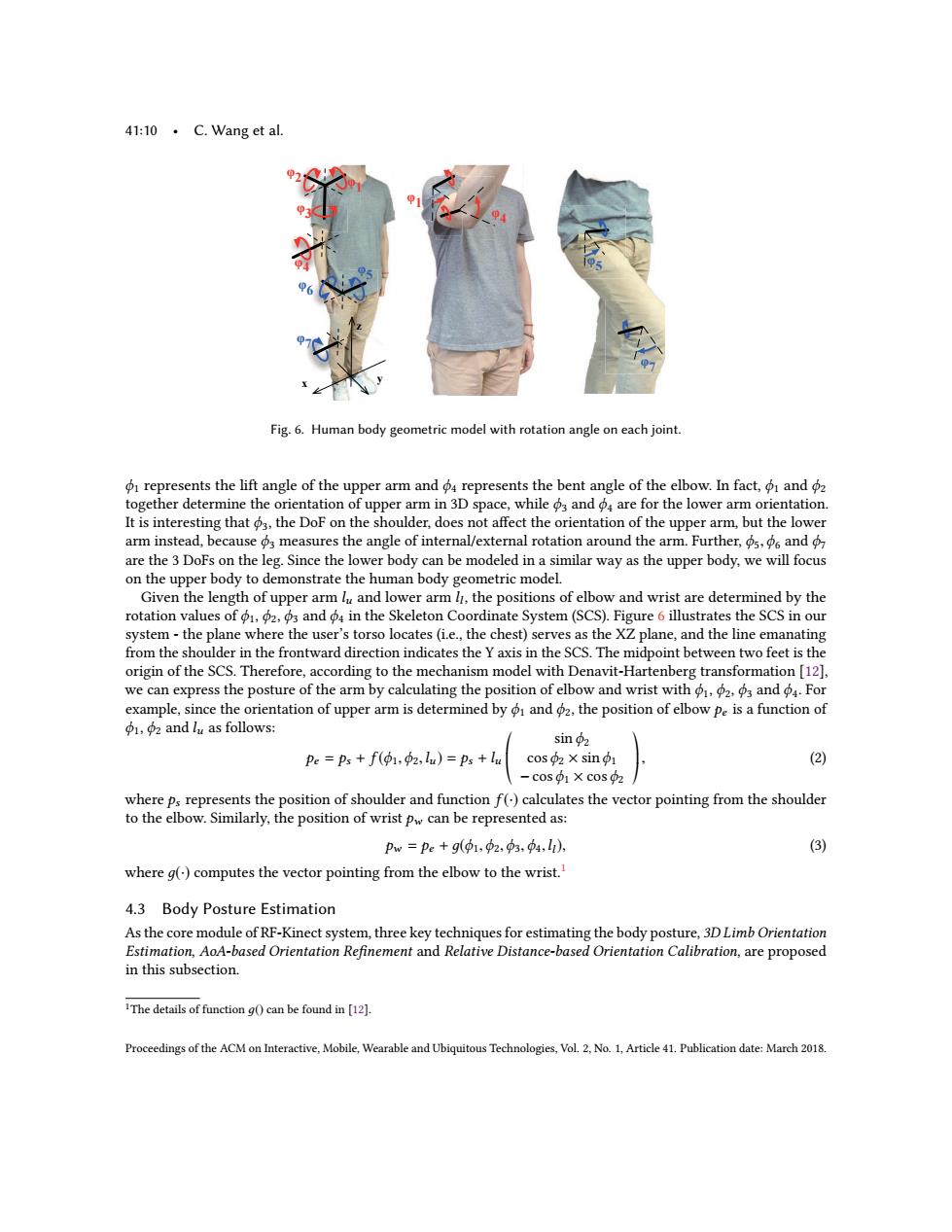正在加载图片...

41:10·C.Wang et al,. Fig.6.Human body geometric model with rotation angle on each joint. represents the lift angle of the upper arm and represents the bent angle of the elbow.In fact,and together determine the orientation of upper arm in 3D space,while 3 and are for the lower arm orientation It is interesting that the DoF on the shoulder,does not affect the orientation of the upper arm,but the lower arm instead,because measures the angle of internal/external rotation around the arm.Further,,and are the 3 DoFs on the leg.Since the lower body can be modeled in a similar way as the upper body,we will focus on the upper body to demonstrate the human body geometric model. Given the length of upper arm lu and lower arm l,the positions of elbow and wrist are determined by the rotation values of 2,3 and 4 in the Skeleton Coordinate System(SCS).Figure 6 illustrates the SCS in our system-the plane where the user's torso locates(i.e.,the chest)serves as the XZ plane,and the line emanating from the shoulder in the frontward direction indicates the Y axis in the SCS.The midpoint between two feet is the origin of the SCS.Therefore,according to the mechanism model with Denavit-Hartenberg transformation [12], we can express the posture of the arm by calculating the position of elbow and wrist with 2,3 and 4.For example,since the orientation of upper arm is determined by and 2,the position of elbow pe is a function of 1,2 and lu as follows: sin 2 Pe Ps f(o1,2 lu)=ps lu cos o2 X sini (2) cos o1 x cos o where ps represents the position of shoulder and function f()calculates the vector pointing from the shoulder to the elbow.Similarly,the position of wrist pw can be represented as: Pw =pe +g(o1,2,) (3) where g()computes the vector pointing from the elbow to the wrist.! 4.3 Body Posture Estimation As the core module of RF-Kinect system,three key techniques for estimating the body posture,3D Limb Orientation Estimation,AoA-based Orientation Refinement and Relative Distance-based Orientation Calibration,are proposed in this subsection. IThe details of function g()can be found in [12]. Proceedings of the ACM on Interactive,Mobile,Wearable and Ubiquitous Technologies,Vol.2,No.1,Article 41.Publication date:March 2018.41:10 • C. Wang et al. ! " # $ % & ' $ ' ( ) * ( * Fig. 6. Human body geometric model with rotation angle on each joint. ϕ1 represents the lift angle of the upper arm and ϕ4 represents the bent angle of the elbow. In fact, ϕ1 and ϕ2 together determine the orientation of upper arm in 3D space, while ϕ3 and ϕ4 are for the lower arm orientation. It is interesting that ϕ3, the DoF on the shoulder, does not affect the orientation of the upper arm, but the lower arm instead, because ϕ3 measures the angle of internal/external rotation around the arm. Further, ϕ5,ϕ6 and ϕ7 are the 3 DoFs on the leg. Since the lower body can be modeled in a similar way as the upper body, we will focus on the upper body to demonstrate the human body geometric model. Given the length of upper arm lu and lower arm ll , the positions of elbow and wrist are determined by the rotation values of ϕ1, ϕ2, ϕ3 and ϕ4 in the Skeleton Coordinate System (SCS). Figure 6 illustrates the SCS in our system - the plane where the user’s torso locates (i.e., the chest) serves as the XZ plane, and the line emanating from the shoulder in the frontward direction indicates the Y axis in the SCS. The midpoint between two feet is the origin of the SCS. Therefore, according to the mechanism model with Denavit-Hartenberg transformation [12], we can express the posture of the arm by calculating the position of elbow and wrist with ϕ1, ϕ2, ϕ3 and ϕ4. For example, since the orientation of upper arm is determined by ϕ1 and ϕ2, the position of elbow pe is a function of ϕ1, ϕ2 and lu as follows: pe = ps + f (ϕ1,ϕ2,lu ) = ps + lu © « sinϕ2 cosϕ2 × sinϕ1 − cosϕ1 × cosϕ2 ª ® ¬ , (2) where ps represents the position of shoulder and function f (·) calculates the vector pointing from the shoulder to the elbow. Similarly, the position of wrist pw can be represented as: pw = pe + д(ϕ1,ϕ2,ϕ3,ϕ4,ll), (3) where д(·) computes the vector pointing from the elbow to the wrist.1 4.3 Body Posture Estimation As the core module of RF-Kinect system, three key techniques for estimating the body posture, 3D Limb Orientation Estimation, AoA-based Orientation Refinement and Relative Distance-based Orientation Calibration, are proposed in this subsection. 1The details of function д() can be found in [12]. Proceedings of the ACM on Interactive, Mobile, Wearable and Ubiquitous Technologies, Vol. 2, No. 1, Article 41. Publication date: March 2018